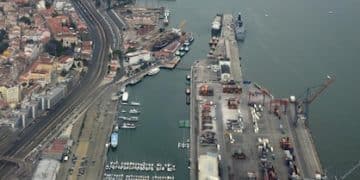Peru’s Trade Agreements: Impact on US Exporters Explained

Peru’s evolving stance on international trade agreements can significantly influence the competitive landscape for US exporters, affecting market access, tariffs, and overall trade dynamics.
Understanding how will Peru’s stance on international trade agreements affect US exporters is crucial for businesses engaged in or planning to enter the Peruvian market. This analysis explores the potential impacts, providing insights for strategic decision-making.
Peru’s Evolving Trade Policy: An Overview
Peru has historically embraced international trade, forging agreements with numerous countries to boost its economy. However, recent shifts in political sentiment have led to a re-evaluation of these agreements, raising concerns about potential impacts on trade partners, including the United States.
This section delves into the specific trade agreements Peru has in place and explores any signals the current administration is sending regarding potential renegotiations or revisions.
Key Trade Agreements Involving Peru
Peru is a member of the World Trade Organization (WTO) and has signed free trade agreements (FTAs) with major economies worldwide. Additionally, Peru is a member of the Comprehensive and Progressive Agreement for Trans-Pacific Partnership (CPTPP), benefiting the nation immensely in the global market. These agreements have significantly influenced trade patterns and economic growth.
- US-Peru Trade Promotion Agreement: This comprehensive agreement eliminates tariffs and promotes trade in goods and services between the two countries.
- CPTPP (Comprehensive and Progressive Agreement for Trans-Pacific Partnership): As a member, Peru benefits from reduced trade barriers with eleven other countries in the Asia-Pacific region.
- Trade Agreements with the European Union: These agreements establish preferential trade terms, facilitating the export of Peruvian goods to European markets.
These are some of the most impacting trade agreements Peru has, and it’s important to be aware of its current stance on them.
In conclusion, Peru’s trade policy is currently in a transformative phase, with potential ramifications for international trade dynamics and its role on the global stage. This overview establishes the groundwork for understanding the possible impacts on US exporters.

Potential Renegotiations: What’s on the Table?
Recent political discourse in Peru suggests a growing interest in renegotiating existing trade agreements to better serve national interests. These potential renegotiations could cover various aspects of the agreements, including tariff rates, intellectual property rights, and investment protections.
The prospect of renegotiations introduces uncertainty for US exporters, who rely on the established terms of existing agreements. Understanding the specific areas under scrutiny is essential for assessing potential risks and opportunities.
Areas of Focus in Potential Renegotiations
The discussions around potential trade agreement renegotiations often center on several key areas, influenced by both domestic political considerations and global economic trends.
- Tariff Adjustments: Renegotiations may involve altering tariff rates on specific products, potentially increasing the cost of exporting goods from the US to Peru.
- Intellectual Property Rights: Changes to intellectual property protections could affect US companies that rely on patents, trademarks, and copyrights in the Peruvian market.
- Investment Protections: Renegotiations could lead to revisions in investment protection clauses, impacting the security and profitability of US investments in Peru.
It’s important to closely oversee what the government is planning to do with these agreements.
In final remarks, potential renegotiations of trade agreements present both challenges and opportunities for US exporters. Careful monitoring of these developments and proactive engagement with policymakers are crucial for navigating the evolving trade landscape in Peru.
The Impact on Key Export Sectors
The implications of Peru’s stance on trade agreements vary across different export sectors. Certain industries may face greater challenges than others, depending on the specific provisions of the agreements and the nature of the goods being traded.
Identifying vulnerable sectors and assessing the potential impact on their competitiveness is essential for US exporters to strategize and mitigate risks.
Analysis of Vulnerable Export Sectors
Understanding which export sectors are most likely to be affected by changes in Peru’s trade policy is crucial for US businesses. Several sectors stand out as particularly vulnerable, based on the nature of their products and their reliance on preferential trade terms.
Some sectors most at risk include:
- Agriculture and Food Products;
- Machinery and Equipment;
- Chemicals and Pharmaceuticals.
As can be seen, several industries are impacted, affecting lots of workers internationally.

In brief, the impact of Peru’s evolving trade policy on US exporters is sector-specific, with some industries facing greater challenges than others. This analysis underscores the importance of understanding these dynamics and tailoring strategies accordingly.
Strategies for US Exporters: Navigating Uncertainty
In the face of uncertainty surrounding Peru’s trade policies, US exporters need to adopt proactive strategies to mitigate risks and capitalize on opportunities. These strategies may include diversifying markets, seeking alternative trade agreements, and engaging with government officials.
Successful adaptation requires careful planning and a willingness to adjust business models to the changing trade environment.
Proactive Measures for US Exporters
To navigate the uncertain trade landscape in Peru, US exporters can implement several proactive measures that minimize potential disruptions and maximize opportunities. These actions encompass market diversification, exploration of alternative trade agreements, and robust engagement with policymakers.
- Market Diversification: Reduce dependence on the Peruvian market by exploring alternative export destinations.
- Leveraging Alternative Trade Agreements: Utilize existing trade agreements with other countries to offset potential losses in Peru.
- Engaging with Policymakers: Advocate for policies that promote fair and open trade between the US and Peru.
There are many steps one can follow to try to limit potential monetary losses.
In final remarks, US exporters can successfully navigate the uncertainty surrounding Peru’s trade policies by adopting proactive measures, diversifying markets, leveraging alternative trade agreements, and actively engaging with policymakers.
The Role of US Government Initiatives
The US government plays a crucial role in supporting US exporters facing challenges in international markets. Government initiatives such as trade missions, export financing programs, and diplomatic efforts can provide valuable assistance to businesses seeking to expand their presence in Peru.
Understanding and leveraging these resources is essential for US exporters to overcome obstacles and maintain their competitiveness.
Government Support and Resources
The U.S. government offers a plethora of resources to aid exporters in navigating international challenges. These supports come in diverse forms, including financial assistance, educational programs, and diplomatic backing. Specifically, these programs are designed to boost the presence of American businesses in foreign sectors.
Some programs include:
- Export-Import Bank of the United States (EXIM);
- Small Business Administration (SBA);
- U.S. Commercial Service.
All of these programs are designed to assist US companies interested in international sales.
In summary, the U.S. government plays a vital role in ensuring that exporters are well-equipped to face any challenge in foreign markets. By supporting diverse programs, it promotes a strong, competitive presence for companies in Peru and elsewhere.
Long-Term Outlook: Peru’s Place in Global Trade
Looking ahead, Peru’s long-term role in global trade will depend on its ability to balance domestic policy objectives with the need to maintain stable and predictable trade relationships. A commitment to transparency and adherence to international norms will be crucial for attracting foreign investment and fostering sustainable economic growth.
Understanding the broader context of Peru’s trade policy within the global landscape is essential for US exporters to make informed decisions about their long-term strategies.
Peru’s Trade Trajectory
As we look into the future, it’s essential to gauge which path Peru might take in the domain of global trade and how that will affect international commerce. The decisions made by the country involving trade will immensely shape its economic growth and its interaction with other global economies, particularly the economy of the USA.
Some Key Points Regarding Peru’s Trade Trajectory:
- Maintaining Trade Relations;
- Investment in Infrastructure;
- Regulatory Improvements.
As can be seen, Peru is on a dynamic path of economical improvements that will benefit both the country and the USA.
| Key Point | Brief Description |
|---|---|
| ⚠️ Renegotiation Impact | Potential tariff adjustments can increase export costs. |
| 🚜 Sector Vulnerability | Agriculture, machinery, and chemicals face higher risks. |
| 🤝 Government Support | EXIM Bank and SBA offer export assistance programs. |
| 💼 Strategy Adaptation | Diversify markets to reduce dependency on Peru. |
FAQ
▼
Tariffs increase the cost of US goods in Peru, making them less competitive compared to local products or imports from countries with more favorable trade agreements. This can reduce export volumes and market share.
▼
The most vulnerable sectors include agriculture, machinery, chemicals, and pharmaceuticals. These sectors often rely on preferential tariff rates and stable trade conditions to maintain their competitiveness in the Peruvian market.
▼
Market diversification reduces reliance on a single market like Peru. By expanding sales to other countries, US exporters can mitigate risks associated with policy changes or economic downturns in any one particular region.
▼
Yes, the US government offers various programs through agencies like the EXIM Bank and SBA. These initiatives provide financial assistance, insurance, and resources to help US exporters succeed in international markets, including Peru.
▼
Peru participates in trade agreements like the US-Peru Trade Promotion Agreement and CPTPP. These agreements reduce trade barriers and aim at fostering economic cooperation amongst member nations, affecting how the US exports to Peru.
Conclusion
In conclusion, Peru’s stance on international trade agreements holds considerable implications for US exporters. By staying well informed, strategically adapting, and leveraging available resources, businesses can navigate the evolving landscape and maintain a competitive edge in the Peruvian market.





